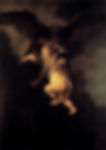Rembrandt - Ganymede
- Alexandra Tuschka
- 4. Jan. 2021
- 3 Min. Lesezeit
Aktualisiert: 7. Jan. 2021
by Alexandra Tuschka
The young shepherd Ganymede drives his sheep to the meadows. Since he is the most beautiful of all young boys, also God-father Zeus becomes attentive to him; he wants to make him his cupbearer. In the form of an eagle, he approaches the boy, seizes him before the eyes of his companions and carries him off to Mount Olympus.
A spicy and famous depiction of Ganymede can be found today in the Old Masters Picture Gallery in Dresden. The Dutchman Rembrandt decided in 1635, contrary to every pictorial tradition, to depict the boy as a crying, chubby and probably quite unsightly toddler. The painting appears gloomy. Only Ganymede, placed in the center of the picture, is designed in bright colors and becomes the first eye-catcher of the picture. The boy is basically seen backwards, but turns his face to the viewer over his left shoulder - Ganymede has his eyes closed, his mouth is wide open and his nose is wrinkled.

In his left hand the boy holds a bunch of cherries, the right hand, however, is stretched out and seems to want to push the eagle away. He wears a shirt, which, however, is pulled up by the claws of the bird and thus exposed parts of his back and bare buttocks. A round belly can also be seen in profile. A red tassel dangles in front of it. And something else strikes us funny - the boy urinates!
The imposing eagle has spread its wings so far that the edge of the picture clips them on both sides. The bird has deep black eyes, and contrary to the opinion that the eagle is the most dignified of all birds, this one does not express any lightness. Nothing majestic is recognizable - wings, claws, beak and gaze illustrate his laborious purpose.
In the background, the dark cloud formation is divided by a diagonal, lighter burst of light. The rest of the background is only fuzzily discernible. Architectural elements in the lower left and a wooded area in the lower right still faintly symbolize the mundane sphere from which Ganymede is snatched.
The inverted triangular composition of the group also represents an extremely unstable formation that supports the pictorial theme. The emphasis on Ganymede's buttocks and legs pull the composition downward. Rembrandt nevertheless arranges the group slightly above the center of the painting to suggest that the eagle will succeed in his endeavor and eventually carry Ganymede off into the sky. Quite intuitively, the painting has a parodic effect on the viewer, and for decades there has been speculation about what exactly Rembrandt wanted to take for a ride - was it antiquity itself, the treatment of it, or both at the same time?
For this, one must understand that most artists before Rembrandt depicted this scene in a very removed way. Here we find mostly very beautiful youths who let themselves be carried off to heaven by mutual consent. The motif was also often associated with homoeroticism, which is why Ganymede is often seen with a bare bottom. Rembrandt has freely parodied this scene here.
Research opinions could not be more divided - on the one hand, Rembrandt could be a naive and vulgar immoralist who worked without understanding of the classical "decorum", on the other hand, a scholar who pulled out all the stops of humanistic education in his Ganymede painting and subtly revealed political and socially critical statements.
Rembrandt - Ganymede
Oil on canvas, 1635, 177 x 130 cm, Gallery Old Masters in Dresden






